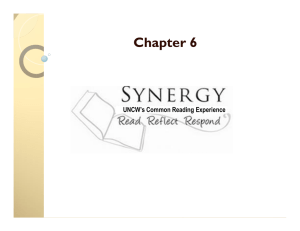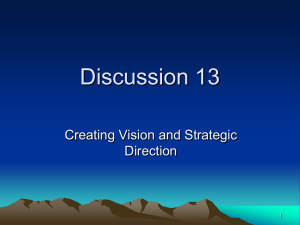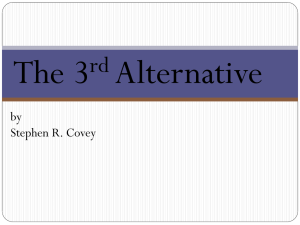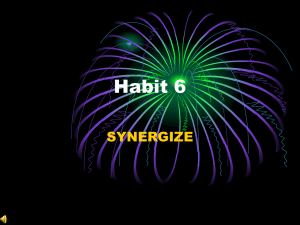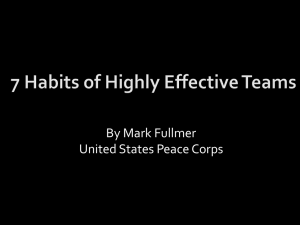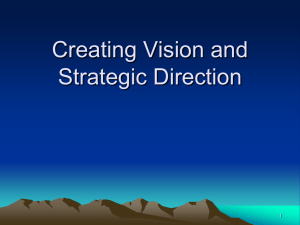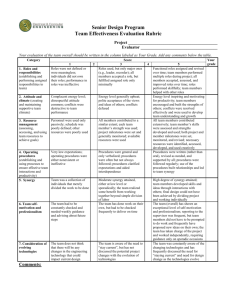Using Virtual Synergy for Artificial Intelligence and Robotics Education Sheila Tejada
advertisement
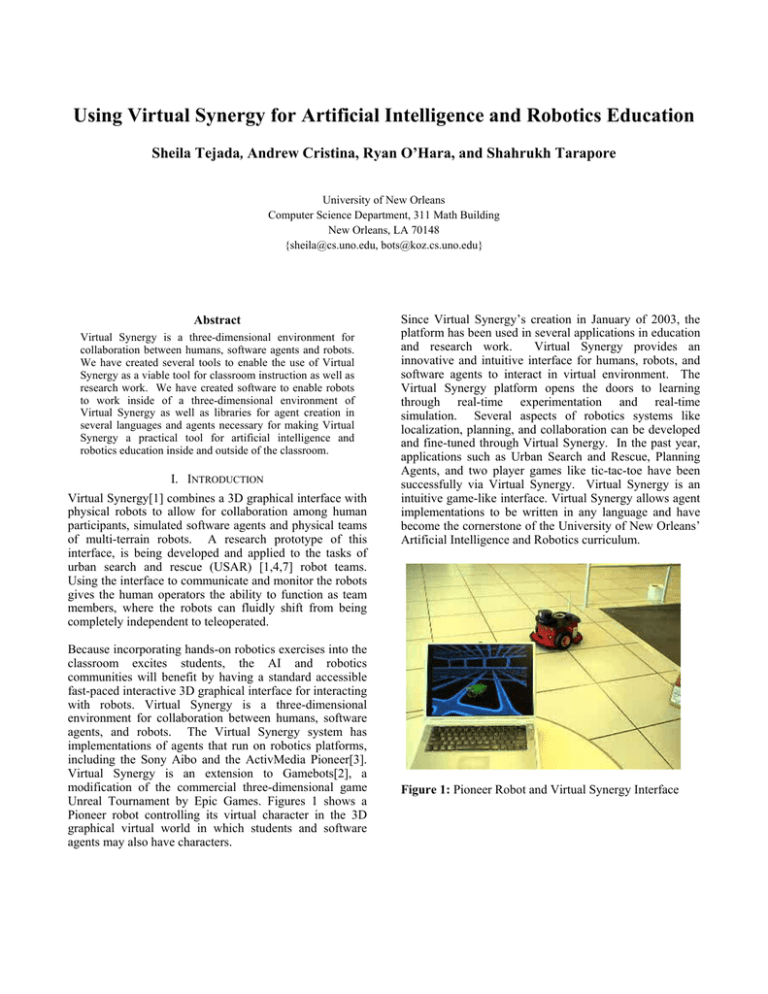
Using Virtual Synergy for Artificial Intelligence and Robotics Education
Sheila Tejada, Andrew Cristina, Ryan O’Hara, and Shahrukh Tarapore
University of New Orleans
Computer Science Department, 311 Math Building
New Orleans, LA 70148
{sheila@cs.uno.edu, bots@koz.cs.uno.edu}
Abstract
Virtual Synergy is a three-dimensional environment for
collaboration between humans, software agents and robots.
We have created several tools to enable the use of Virtual
Synergy as a viable tool for classroom instruction as well as
research work. We have created software to enable robots
to work inside of a three-dimensional environment of
Virtual Synergy as well as libraries for agent creation in
several languages and agents necessary for making Virtual
Synergy a practical tool for artificial intelligence and
robotics education inside and outside of the classroom.
I. INTRODUCTION
Virtual Synergy[1] combines a 3D graphical interface with
physical robots to allow for collaboration among human
participants, simulated software agents and physical teams
of multi-terrain robots. A research prototype of this
interface, is being developed and applied to the tasks of
urban search and rescue (USAR) [1,4,7] robot teams.
Using the interface to communicate and monitor the robots
gives the human operators the ability to function as team
members, where the robots can fluidly shift from being
completely independent to teleoperated.
Because incorporating hands-on robotics exercises into the
classroom excites students, the AI and robotics
communities will benefit by having a standard accessible
fast-paced interactive 3D graphical interface for interacting
with robots. Virtual Synergy is a three-dimensional
environment for collaboration between humans, software
agents, and robots. The Virtual Synergy system has
implementations of agents that run on robotics platforms,
including the Sony Aibo and the ActivMedia Pioneer[3].
Virtual Synergy is an extension to Gamebots[2], a
modification of the commercial three-dimensional game
Unreal Tournament by Epic Games. Figures 1 shows a
Pioneer robot controlling its virtual character in the 3D
graphical virtual world in which students and software
agents may also have characters.
Since Virtual Synergy’s creation in January of 2003, the
platform has been used in several applications in education
and research work.
Virtual Synergy provides an
innovative and intuitive interface for humans, robots, and
software agents to interact in virtual environment. The
Virtual Synergy platform opens the doors to learning
through real-time experimentation and real-time
simulation. Several aspects of robotics systems like
localization, planning, and collaboration can be developed
and fine-tuned through Virtual Synergy. In the past year,
applications such as Urban Search and Rescue, Planning
Agents, and two player games like tic-tac-toe have been
successfully via Virtual Synergy. Virtual Synergy is an
intuitive game-like interface. Virtual Synergy allows agent
implementations to be written in any language and have
become the cornerstone of the University of New Orleans’
Artificial Intelligence and Robotics curriculum.
Figure 1: Pioneer Robot and Virtual Synergy Interface
II. VIRTUAL SYNERGY
The Virtual Synergy platform consists of several
components. One such component is the Virtual Synergy
text-based protocol, which allows agents to be
implemented in any language with TCP/IP sockets. This
allows us to learn about robotics and automation without
the burden of using a language they have no development
experience with. Current agents have been implemented in
languages such as: Java, C++, and Common Lisp. Future
agents are planned in Python and other languages with a
network socket implementation.
the virtual world so are the victims that are found. Once
the Aibo has completely traversed the maze it will have
created a detailed map in Virtual Synergy.
Figure 4: Pioneer robot traversing maze search for targets
Figure 3: Clients connect to Gamebots server via a network.
Virtual Synergy also adds support for agents running on
robotics platforms such as the Sony Aibo and the
ActivMedia Pioneer. Because Virtual Synergy is based on
a simple text protocol, any robotics platform that supports
TCP/IP can host an agent.
III. VIRTUAL SYNERGY IN THE CLASSROOM
A. Urban Search and Rescue
Urban Search and Rescue is the search and rescue of
people trapped in collapsed man-made structures [3].
Robots are expendable and therefore a suitable alternative
to humans entering a collapsed structure then searching for
and rescuing victims inside.
In the spring of 2003, a scaled down version of this
application was a class project. The objective was to
traverse a maze with obstacles (i.e. a collapsed structure),
search for target objects (i.e. victims), and map the
victims’ location in the virtual world. We used the Sony
Aibo robot and ActivMedia Pioneer to traverse an
unknown maze. Using a left wall-following algorithm, the
Aibo would send environmental information to Virtual
Synergy. Environmental information includes obstacle
and wall locations. Agents using Virtual Synergy can
build a three-dimensional representation of the
environment. When the Aibo locates a victim it send
location information of the target object to Virtual
Synergy. Just as walls and obstacles were represented in
B. Tic-Tac-Toe
In fall of 2003, the graduate artificial intelligence class was
given the assignment to make a robot play tic-tac-toe with
a human. The game is set up as follows: 9 squares were
taped off on the floor with four different colored tapes,
where no two adjacent squares were the same color. The
robot used in this project was a Sony Aibo. The robot and
opponent will alternate turns placing markers in the Virtual
Synergy interface. Changes in the game board are
communicated to the robot and used to formulate the
robots subsequent moves. When the robot chooses a move
to make it communicates that move to the Virtual Synergy
Interface where it is represented for the human. At the
same time the robot is physically moving to the
corresponding square on the floor to place a marker. Once
the robot knows its location it can move to its new
location. Then the robot places a marker on its new square
and waits for the opponent to complete its turn. Through
this project students investigated artificial intelligence
methods by implementing two player search and constraint
satisfaction techniques.
Figure 5: Sony Aibo robot in tic-tac-toe board.
C. Data Recording Agent
Virtual Synergy can represent information about robots
and humans. Virtual Synergy not only represents
information about software agents; it also acts as a sensor
for these software agents. Virtual Synergy allows software
agents implemented in an array of languages to exist in the
virtual world, and use the output of humans, robots, and
other software agents to complete its specified task. The
Data Recording Agent is such an agent with the task of
logging events that occur in the virtual world of Virtual
Synergy.
The Data Recording Agent displays a real-time twodimensional map of everything within the Virtual Synergy
world, while logging this information to file. The Data
Recording Agent can replay previous sessions, allowing
past incarnations of the virtual world to be recreated for
research and performance assessment. In addition the Data
Recording Agents can append new events to an existing
log file.
behavior systems, and the effectiveness of autonomy in the
system[5,6,8].
Figure 7: 3D Map in Virtual Synergy of Figure 6
D. Mission Planning Agent
Another application of Virtual Synergy is the Mission
Planning Agent. This agent’s purpose is to allow other
agents the use of a planner via a documented text protocol.
Any agent wishing to do planning submits a problem
request to the planning agent, and the planning agent
responds with a solution, or in the event there is no
solution, an error message. The agent is implemented in
Lisp, and was the prototype application for the lisp Virtual
Synergy library. The agent uses Sensory Graphplan
(www.cs.washington.edu/ai/sgp.html), developed at the
University of Washington as an extension of Graphplan.
Sensory Graphplan extended Graphplan by allowing for
uncertainty and sensing actions in planning [4].
Figure 6: Two-dimensional map of Virtual Synergy
created by the Data Recording Agent.
The Data Recording Agent, like all other Virtual Synergy
agents, acts on some sensory input available from Virtual
Synergy. The Data Recording Agent’s inputs are the
synchronous sensory messages provided by the Virtual
Synergy umod. Once the agent receives a message, it
records the message to file and updates its twodimensional map with the new information. The twodimensional map can track the actions of all entities in the
virtual world.
The Data Recording Agent allows us to study how well
robot and software agent resources are utilized between
incarnations of the virtual world. The play back feature of
the Data Recording Agent allows a previous incarnation to
be recreated in the two and three-dimensional maps. Using
the play back feature of the Data Recording Agent will
improve the design of software agents, efficiency of robot
In the spring of 2004, the University of New Orleans’
introductory artificial intelligence class will use the
planning agent as part of their final project, which is
creating social agents. The University of New Orleans
robotics team will also use the planning agent in our Urban
Search and Rescue application.
The Lisp library
developed for the agent will also be made available to
those who wish to use Lisp in the artificial intelligence
class.
IV. VIRTUAL SYNERGY OUTSIDE THE CLASSROOM
The UNO Robotics Team attended the IJCAI-03 in
Acapulco, Mexico. While attending the conference the
team competed in the AAAI Robot Rescue Competition.
This year was the first year our team competed in the
USAR competition. The team finished with the third
highest score and earned a technical award for an
innovative three dimensional map created by the Virtual
Synergy user interface. The competition consisted of three
preliminary runs for all teams, and two final runs for the
top four teams. The UNO Robotics Team was the only
team to roughly double its score in each run. The UNO
Robotics Team’s platform has shown itself to be flexible
and dynamic.
In the first two runs, the team used four Aibo robots, one
blimp, and three human operators. The Aibos were
individually tele-operated by two of the human operators
and the third operator remotely controlled the blimp. The
blimp operator also assumed the role of mapmaker. As the
human controllers gathered data from the environment,
they verbally communicated with the mapmaker to build a
global map in the three dimensional environment. The
Aibos’ integration with Virtual Synergy allowed for more
consistent mapping of the environment. The team is
currently developing an autonomous multi-agent system.
to concentrate on artificial intelligence concepts instead of
on language syntax and semantics. In addition, Virtual
Synergy uses a familiar intuitive three-dimensional user
interface [10]. In conclusion, Virtual Synergy can as serve
as a basis for a number of class projects on artificial
intelligence and robots, well as for research on humanrobot interfaces and human-robot-agent collaboration
[9,11,12].
Figure 11: Human-Robot-Agent collaboration in Virtual
Synergy.
References
[1] Sheila Tejada, Andrew Cristina, Priscilla Goodwyne, Eric
Figure 10: Robots finding victim in orange test arena
Normand, Ryan O'Hara, and Shahrukh Tarapore, Virtual
Synergy: A Human-Robot Interface for Urban Search and
Rescue. In the Proceedings of the AAAI 2003 Robot
Competition, Acapulco, Mexico 2003.
[2] Rogelio Adobbati, Andrew N. Marshall, Andrew Scholer,
V. CONCLUSION
Virtual Synergy is the cornerstone of University of New
Orleans’ artificial intelligence and robotics curriculum.
Virtual Synergy has been used as a visualization and mapmaking tool for Urban Search and Rescue research. It has
also been used for multi-agent collaboration work.
Students at University of New Orleans have built software
agents in many languages to work with Virtual Synergy,
including agents running on robotics platforms. Students
in a graduate artificial intelligence class wrote tic-tac-toe
software for Virtual Synergy, allowing humans and agents
to play tic-tac-toe in a virtual world, while having the robot
play the same game on a physical board. Other students
used Virtual Synergy for implementing a solution to a
subset of the Urban Search and Rescue domain. Virtual
Synergy allows students to use a familiar language in order
Sheila Tejada, Gal Kaminka, Steven Schaffer, and Chris
Sollitto. Gamebots: A 3D Virtual World Test-Bed For
Multi-Agent Research, Proceedings of the International
Conference on Autonomous Agents (Agents-2001) Workshop
on Infrastructure for Agents, MAS, and Scalable MAS,
Montreal, Canada, 2001.
[3] Brian P. Gerkey, Richard T. Vaughan, Kasper Støy, Andrew
Howard, Gaurav S. Sukhatme, and Maja J. Mataric. Most
Valuable Player: A Robot Device Server for Distributed
Control, Proceedings of the IEEE/RSJ International
Conference on Intelligent Robots and Systems (IROS 2001),
pages 1226-1231, Wailea, Hawaii, October 29 - November
3, 2001.
[4] R. Murphy, J. Casper, M. Micire, and J. Hyams. Mixedinitiative Control of Multiple Heterogeneous Robots for
USAR.
[5] D. Perzanowski, A. C. Shultz, W. Adams, M. Bugajska, E.
Marsh, J. G. Trafton, D. Brock, M. Skubic, M. Abramson.
Communicating with Teams of Cooperative Robots in (Eds.)
A.C. Schultz and L. E. Parker. Multi-Robot Systems: From
Swarms to Intelligent Automata, pages 177-184, Kluwer
Academic Publishers, Dordrecht, The Netherlands, 2002.
[6] Jean C. Scholtz. Human-Robot Interactions: Creating
Synergistic Cyber Forces in (Eds.) A.C. Schultz and L. E.
Parker. Multi-Robot Systems: From Swarms to Intelligent
Automata, pages 177-184, Kluwer Academic Publishers,
Dordrecht, The Netherlands, 2002.
[7] J. Casper, Human-Robot Interactions during the RobotAssisted Urban Search and Rescue Response at the World
Trade Center, MS Thesis, Computer Science and
Engineering, USF, Apr. 2002.
[8] David Kortenkamp, Tod Milam, Reid Simmons and Joaquin
Lopez Fernandez, A Suite of Tools for Debugging
Distributed Autonomous Systems, in Proceedings of the
IEEE International Conference on Robotics and
Automation, 2002.
[9] David Kortenkamp, Debra Schreckenghost and Cheryl
Martin, User Interaction with Multi-Robot Systems, in
Workshop on Multi-Robot Systems, 2002.
[10] Laird, J.E. and van Lent, M. Human-level AI’s Killer
Application: Interactive Computer Games. AAAI Fall
Symposium
Technical
Report,
North
Falmouth,
Massachusetts, 2000, 80-97.
[11] Mitchell A. Potter, Lisa A. Meeden, and Alan C. Schultz
(2001). Heterogeneity in the Coevolved Behaviors of
Mobile Robots: The Emergence of Specialists. Proceedings
of Seventeenth International Joint Conference on Artificial
Intelligence, Seattle, Washington, 2001.
[12] D. Schreckenghost, C. Thronesbery, P. Bonasso, D.
Kortenkamp and C. Martin, Intelligent Control of Life
Support for Space Missions, in IEEE Intelligent Systems
Magazine, September/October, 2002.
